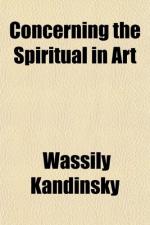Painting is, however, in a different position. The revolt from dependence on nature is only just beginning. Any realization of the inner working of colour and form is so far unconscious. The subjection of composition to some geometrical form is no new idea (cf. the art of the Persians). Construction on a purely abstract basis is a slow business, and at first seemingly blind and aimless. The artist must train not only his eye but also his soul, so that he can test colours for themselves and not only by external impressions.
If we begin at once to break the bonds which bind us to nature, and devote ourselves purely to combination of pure colour and abstract form, we shall produce works which are mere decoration, which are suited to neckties or carpets. Beauty of Form and Colour is no sufficient aim by itself, despite the assertions of pure aesthetes or even of naturalists, who are obsessed with the idea of “beauty.” It is because of the elementary stage reached by our painting that we are so little able to grasp the inner harmony of true colour and form composition. The nerve vibrations are there, certainly, but they get no further than the nerves, because the corresponding vibrations of the spirit which they call forth are too weak. When we remember, however, that spiritual experience is quickening, that positive science, the firmest basis of human thought, is tottering, that dissolution of matter is imminent, we have reason to hope that the hour of pure composition is not far away.
It must not be thought that pure decoration is lifeless. It has its inner being, but one which is either incomprehensible to us, as in the case of old decorative art, or which seems mere illogical confusion, as a world in which full-grown men and embryos play equal roles, in which beings deprived of limbs are on a level with noses and toes which live isolated and of their own vitality. The confusion is like that of a kaleidoscope, which though possessing a life of its own, belongs to another sphere. Nevertheless, decoration has its effect on us; oriental decoration quite differently to Swedish, savage, or ancient Greek. It is not for nothing that there is a general custom of describing samples of decoration as gay, serious, sad, etc., as music is described as Allegro, Serioso, etc., according to the nature of the piece.
Probably conventional decoration had its beginnings in nature. But when we would assert that external nature is the sole source of all art, we must remember that, in patterning, natural objects are used as symbols, almost as though they were mere hieroglyphics. For this reason we cannot gauge their inner harmony. For instance, we can bear a design of Chinese dragons in our dining or bed rooms, and are no more disturbed by it than by a design of daisies.
It is possible that towards the close of our already dying epoch a new decorative art will develop, but it is not likely to be founded on geometrical form. At the present time any attempt to define this new art would be as useless as pulling a small bud open so as to make a fully blown flower. Nowadays we are still bound to external nature and must find our means of expression in her. But how are we to do it? In other words, how far may we go in altering the forms and colours of this nature?




